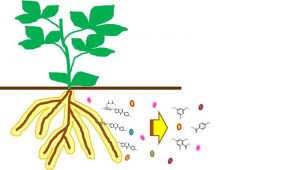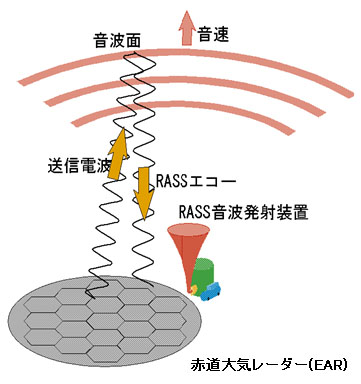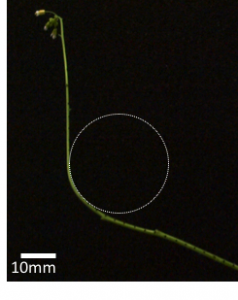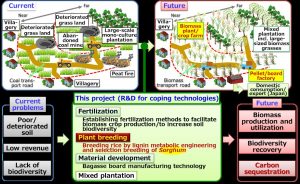2018 Activity Report for Mission 1: Environmental Diagnosis and Regulation of Circulatory Function
Updated: 2019/04/25
Research1:Biosphere−Atmosphere Exchange of Trace Molecules
Principal Investigator (PI): K. Takahashi (RISH, Kyoto University)
Research collaborator(s): Y. Kosugi (Graduate School of Agriculture, Kyoto University), A. Sakabe (Osaka Pref. Univ.), M. Itoh (Univ. Hyogo), H. Iwata (Shinshu Univ.)
We study carbon dynamics from the ecosystem scale to the plot scale in forest environments through in-situ measurements of trace gas fluxes based on micrometeorological methods and automated closed-chamber techniques.
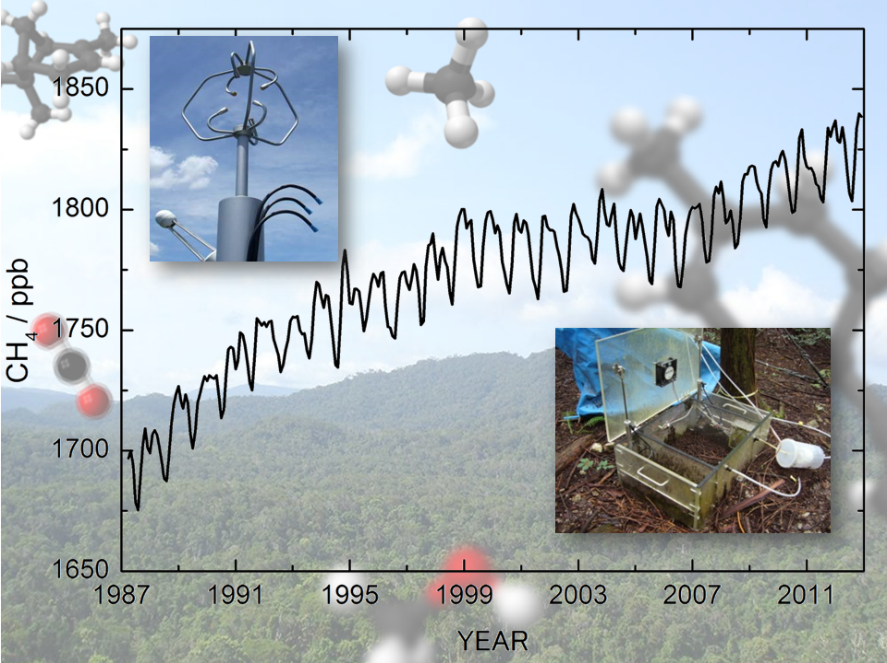
Publication
- Iwata, H., M. Mano, K. Ono, T. Tokida, T. Kawazoe, Y. Kosugi, A. Sakabe, K. Takahashi, and A. Mityata, Exploring sub-daily to seasonal variations in methane exchange in a single-crop rice paddy in central Japan, Atmospheric Environment, 179, 156-165, doi: 10.1016/j.atmosenv.2018.02.015, 2018.
Research 2 :Analysis of plant metabolites in the rhizosphere
Principal Investigator (PI): Akifumi Sugiyama (RISH, Kyoto University)
Research collaborator(s): Shoichiro Hamamoto (Graduate School of Agriculture and Life Sciences, The University of Tokyo), Naoto Nihei (Graduate School of Agriculture and Life Sciences, The University of Tokyo)
The aim of this research is to elucidate the molecular mechanism of plant microbe interaction in the rhizosphere. We analyze transporter genes and metabolites which are involved in the plant microbe interactions. This year the dynamics of isoflavone in the rhizosphere of soybean was simulated.
Figure. Secretion of isoflavones into the rhizosphere of soybean
Publication
- A Sugiyama, Seizonkenkenkyu 14, 59-61 (2018)
Research 3: High Resolution Observations of Equatorial Temperature Profiles with EAR-RASS
Principal Investigator (PI): Hiroyuki Hashiguchi (RISH, Kyoto University)
Research collaborators: Toshitaka Tsuda (RISH, Kyoto University), Ina Juaeni, Halimurrahman, and Noersomadi (LAPAN, Indonesia)
In the equatorial region, cumulus convection is actively excited by strong solar radiation heating, and solar energy is carried to the whole Earth’s atmosphere by circulation and wave motion driven and excited by them. Especially the Indonesian region is the most active region of cumulus convection activity and it has been generating large year-to-year fluctuations, which have great influence on global environmental change through El Nino etc. We have developed the technique to continuously measure temperature profiles in the tropical troposphere with high time-resolution by adopting Radio Acoustic Sounding System (RASS) to the Equatorial Atmosphere Radar (EAR) at Kototabang, west Sumatra, Indonesia.
Radio Acoustic Sounding System (RASS)
Publications
- Ina J., H. Tabata, Noersomadi, Halimurrahman, H. Hashiguchi, and T. Tsuda, Retrieval of Temperature Profiles using Radio Acoustic Sounding System (RASS) with the Equatorial Atmosphere Radar (EAR) in West Sumatra, Indonesia, Earth, Planets and Space, 70:22, doi:10.1186/s40623-018-0784-x, 2018.
- Ina J., H. Hashiguchi, G. A. Nugroho, Halimurrahman, Safrijon, Ridlo, and T. Tsuda, Variability of the troposphere and the tropopause parameters at the tropical region, 1st International Conference on Tropical Meteorology and Atmospheric Sciences (invited), Bandung, Indonesia, September 19-20, 2018.
- Ina J., H. Tabata, Noersomadi, Halimurrahman, H. Hashiguchi, and T. Tsuda, The Effect of the Acoustic Source Location on the Height Profiles of Virtual Temperature in the Tropical Troposphere, The 3rd Asia Research Node Symposium on Humanosphere Science, Taiwan, September 25-27, 2018.
Research 4: Alteration of cell shape in primary tissue during gravitropism
Principal Investigator (PI): Kei’ichi Baba (RISH, Kyoto University)
Research collaborators: Takako Doi (Unit of Synergetic Studies for Space, Kyoto University), Shoko Tsuji (Center for Ecological Research, Kyoto University), Nanako Matsunaga (RISH, Kyoto University), Hiroyuki Watanabe (Faculty of Agriculture, Tamagawa University)
Primary tissue of a stem in higher plants locates just below the apical meristem and bends to the opposite direction of the gravity vector. This phenomenon is called gravitropism. It is thought that differential growth results the stem bending, but it is not clear what stage gravitropism occurs on. Inflorescence stems of Arabidopsis thaliana were inclined and the actual bending zone was determined by marking and using image analyzing software. The cell shapes of epidermis before and after gravitropism were compared and the cells in bending tissue showed different alteration of the shape from those in elongating tissue.
Publication
- The 82nd Annual Meeting of the Botanical Society of Japan, Hiroshima Japan, Sep 14-16, 2018.
Research 5:Collaborative studies in Fukushima since the Great East Japan Earthquake
Principal Investigator (PI): Yoshikatsu Ueda (RISH, Kyoto University)
Research collaborator(s): Akifumi Sugiyama (RISH, Kyoto University), Shiro Suzuki (RISH, Kyoto University),Naoto Nihei (Graduate School of Agricultural and Life Sciences, The University of Tokyo, Rattanaporn Norarat (Rajamangala University of Technology Lanna, Chiang Rai, Thailand), Minoru Tanigaki (Institute for Integrated Radiation and Nuclear Science, Kyoto University)
Radioactive Cesium fell down to cultivation area around Fukushima prefecture by the accident of Fukushima Daiichi Nuclear Power Plant on 2011. We conducted various methods to clean up soil for agriculture. We investigate the contamination variation around cultivation area by using the walking radiation measurement system KURAMA (Kyoto University RAdiation MApping system) and by direct measuring of radioactive cesium concentration as international collaboration.

Visualizing environmental radiation map via KURAMA (Kyoto University RAdiation MApping system) and direct msurering of Cs-137 concentration
Publications, etc.
- Rattanaporn Norarat, Yoshikatsu Ueda, Introduction of Collaborative Study between Rajamangala University of Technology Lanna (RMUTL), Iwate University and Kyoto University, 8th international symposium of collaborative researches in Fukushima since the Great East Japan Earthquake (390th RISH Symposium), Fukushima, Japan, 2018.12.12
- Yoshikatsu Ueda, Remediation technology for cesium and related application studies using fine bubble water in Fukushima Agriculture Field, First International Workshop on the Application of Fine and Ultrafine Bubbles, Innovacorp Enterprise Centre, Halifax, Canada, 2018.8.28
- Yoshikatsu Ueda, Yomei Tokuda, Naoto Nihei, Minoru Tanigaki , Stanislaw W. Gawlonski, Agricultural Field Measurement of Radioactive Cesium in Fukushima, Central and Eastern European Conference on Health and the Environment (CEECHE), The University of Agriculture in Kraków, Poland, 2018.6.11
Research 6: Observations of atmospheric minor constituents using lidar techniques
Principal Investigator (PI): Masanori Yabuki (RISH, Kyoto University)
Atmospheric lidar is a powerful tool for monitoring atmospheric constituents, which are key parameters for understanding the mechanisms underlying environmental changes and localized extreme weather events. In FY2018, a scanning lidar was developed for observing a special distribution of aerosol particles and water vapor within and above the forest canopies. We have conducted simultaneous observations of the lidar and in-situ measurements in evaluating the accuracy of the lidar-derived atmospheric parameters.
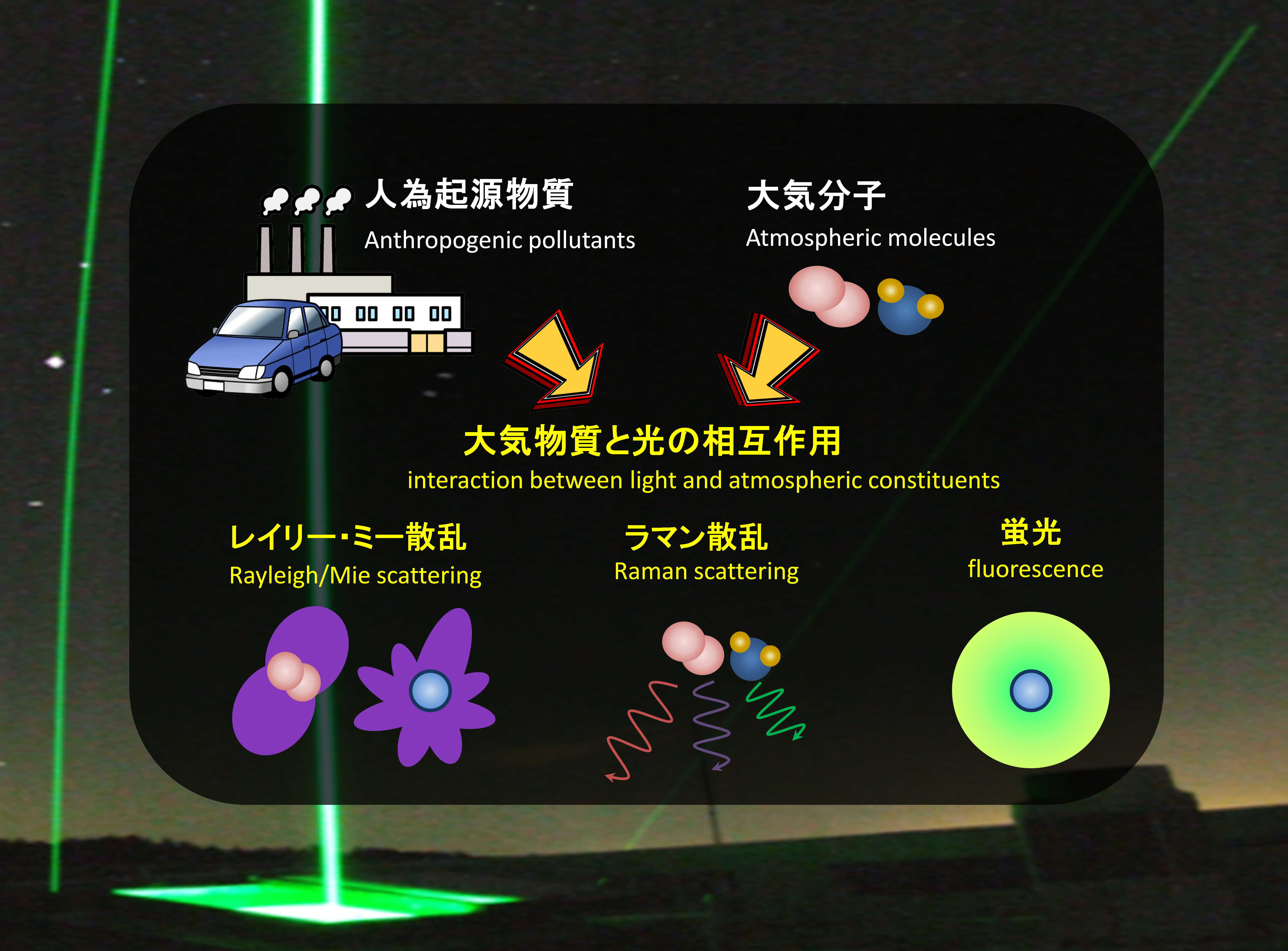
Publication
- F. Kitafuji and M. Yabuki, High spatial resolution aerosol lidar for observing the aerosol distribution within and above the forest canopies, Japan Geoscience Union Meeting 2018, AAS06-P18, 2018.5.20-24.
Research 7:Breeding of gramineous plants toward revegetation of deteriorated grass field and production of biomass energy
Principal Investigator (PI): Toshiaki Umezawa (RISH, Kyoto University)
Research collaborator(s): Yuki Tobimatsu, Takuji Miyamoto, Rie Takada, Yuri Takeda, Masaomi Yamamura, Shiro Suzuki (RISH, Kyoto University), Kosuke Mizuno (CSEAS, Kyoto University), Satoshi Konishi (IAE, Kyoto University), Masahiro Sakamoto (GSA, Kyoto University), Satya Nugroho (LIPI), Safendrri Komara Ragamustari (School of Government & Public Policy, Indonesia)
Appropriate management and revegetation of deteriorated grasslands formed after natural forest logging in Southeast Asia are global issues. In order to address this issue, we have been conducting researches aimed at revegetation of deteriorated grasslands and production of biomass energy. In this fiscal year, as a new development of the above research project, we are conducting the breeding of biomass plants suitable for carbon sequestration combining photovoltaic power generation and biomass production. In particular, we are promoting the breeding of high-productivity grass biomass plants with high carbon content.
Publications, etc.
- Downregulation of p-COUMAROYL ESTER 3-HYDROXYLASE in rice leads to altered cell wall structures and improves biomass saccharification, Y. Takeda, Y. Tobimatsu, S.D. Karlen, T. Koshiba, S. Suzuki, M. Yamamura, S. Murakami, M. Mukai, T. Hattori, K. Osakabe, J. Ralph, M. Sakamoto, T. Umezawa, Plant J., 95, 796-811 (2018)
- Lignin characterization of rice CONIFERALDEHYDE 5‐HYDROXYLASE loss‐of‐function mutants generated with the CRISPR/Cas9 system, Y. Takeda, S. Suzuki, Y. Tobimatsu, K. Osakabe, Y. Osakabe, S. K. Ragamustari, M. Sakamoto, T. Umezawa Plant J. 97, 543–554 (2019)


